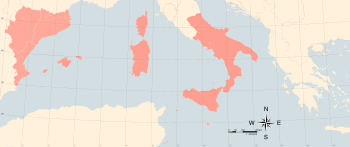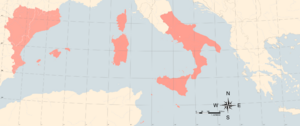Crown of Aragon facts for kids
Quick facts for kids
Crown of Aragon
|
|||||||||||
|---|---|---|---|---|---|---|---|---|---|---|---|
| 1162–1716 | |||||||||||
|
|
|||||||||||

Territories subject to the Crown of Aragon in 1441
|
|||||||||||
| Status | Composite monarchy, confederation of kingdoms, or individual polities ruled by one king | ||||||||||
| Capital | see Capital below | ||||||||||
| Common languages | Official languages: Aragonese, Catalan, Latin Minority languages: Occitan, Sardinian, Corsican, Neapolitan, Sicilian, Castilian, Basque, Greek, Maltese, Andalusian Arabic, Mozarabic |
||||||||||
| Religion | Majority religion: Roman Catholic Minority religions: Sunni Islam, Sephardic Judaism, Greek Orthodoxy |
||||||||||
| Government | Feudal monarchy subject to pacts | ||||||||||
| Monarch | |||||||||||
|
• 1162–1164
|
Petronilla (first) | ||||||||||
|
• 1479-1504
1479–1516 |
Isabella I and Ferdinand II | ||||||||||
|
• 1700–1716
|
Charles III (last) | ||||||||||
| Legislature | Cortz d'Aragón Corts Catalanes Corts Valencianes |
||||||||||
| Historical era | Middle Ages / Early modern period | ||||||||||
|
• Union of the Kingdom of Aragon and the County of Barcelona
|
1162 | ||||||||||
| 1231 | |||||||||||
|
• Conquest of the Kingdom of Valencia
|
1238–1245 | ||||||||||
| 1324–1420 | |||||||||||
| 19 October 1469 | |||||||||||
|
• Conquest of the Kingdom of Naples
|
1501–1504 | ||||||||||
| 1716 | |||||||||||
| Area | |||||||||||
| 1443 | 250,000 km2 (97,000 sq mi) | ||||||||||
|
|||||||||||
| Today part of | |||||||||||
The Crown of Aragon was a powerful group of states in Europe. It was ruled by the same king. This "crown" was not a single country. Instead, it was like a club of different kingdoms and regions. They all shared one ruler. This made it a composite monarchy.
The Crown of Aragon existed for over 500 years. It started in the Middle Ages and lasted into the Early modern period. Its lands covered parts of modern-day Spain, France, and Italy. It also included islands in the Mediterranean Sea.
Contents
What Was the Crown of Aragon?
The Crown of Aragon was a union of many different lands. Each land kept its own laws and customs. They were all connected because they had the same king. This king was known as the King of Aragon.
The main parts of the Crown were:
- The Kingdom of Aragon
- The County of Barcelona (which became the Principality of Catalonia)
- The Kingdom of Valencia
- The Kingdom of Majorca
- The Kingdom of Sicily
- The Kingdom of Naples
- The Kingdom of Sardinia
The city of Zaragoza was an important political center. However, the Crown did not have one single capital city. Different parts had their own important cities.
How the Crown of Aragon Started
The Crown of Aragon began in 1162. This happened when Petronilla of Aragon, the Queen of Aragon, married Ramon Berenguer IV, the Count of Barcelona. Their son, Alfonso II of Aragon, inherited both titles. This joined the Kingdom of Aragon and the County of Barcelona. This union was the start of the Crown of Aragon.
Growing Strong: Expanding the Crown
Over the centuries, the Crown of Aragon grew much larger. Its kings expanded their rule. They conquered new lands, especially around the Mediterranean Sea.
Major Conquests and Expansions
- Conquest of Majorca (1231): King James I of Aragon conquered the Kingdom of Majorca. This included the Balearic Islands.
- Conquest of Valencia (1238–1245): King James I also conquered the Kingdom of Valencia. This added more land on the Iberian Peninsula.
- Conquest of Sicily (1282): The Crown gained control of the Kingdom of Sicily. This was a very important island in the Mediterranean.
- Conquest of Sardinia (1324–1420): The Crown took over the Kingdom of Sardinia. This further increased its power in the sea.
- Conquest of Naples (1501–1504): Later, the Kingdom of Naples in southern Italy was also added. This made the Crown a major player in Italy.
These conquests made the Crown of Aragon a strong naval power. It controlled important trade routes across the Mediterranean.
Life in the Crown of Aragon
Life in the Crown of Aragon was diverse. Many different languages were spoken. These included Aragonese, Catalan, and Latin. People also spoke Occitan, Sardinian, and Neapolitan.
Most people were Roman Catholic. However, there were also communities of Muslims and Jews. The kings often allowed these groups to practice their religions.
The Crown had different parliaments or "Corts" in its various regions. These included the Aragonese Corts and the Catalan Courts. These bodies helped the king govern. They also represented the people of each region.
How the Crown of Aragon Ended
The Crown of Aragon eventually joined with another powerful kingdom. In 1469, Ferdinand II of Aragon married Isabella I of Castile. This marriage united the Crown of Aragon with the Crown of Castile. This union created the basis for modern Spain.
However, the Crown of Aragon still kept its own laws and systems. It was not fully absorbed into Castile right away. This changed much later.
The Crown of Aragon officially ended in 1716. This happened after the War of the Spanish Succession. The new king, Philip V of Spain, issued the Nueva Planta decrees. These decrees abolished the separate laws and institutions of the Crown of Aragon. Its lands became fully part of the new Spanish state.
Images for kids
-
Equestrian heraldic of king Alfonso V of Aragon in the Equestrian armorial of the Golden Fleece 1433–1435. Collection Bibliothèque de l'Arsenal.
-
Ferdinand II of Aragon on his throne flanked by two shields with the emblem of the Royal Seal of Aragon. Frontispiece of a 1495 edition of Catalan constitutions.
-
Ferdinand V and Isabella I, King and Queen of Castile and León, and later of Aragon, Majorca, Valencia, and Sicily
-
Map of Europe and the Mediterranean from the Catalan Atlas of 1375
See also
 In Spanish: Corona de Aragón para niños
In Spanish: Corona de Aragón para niños









